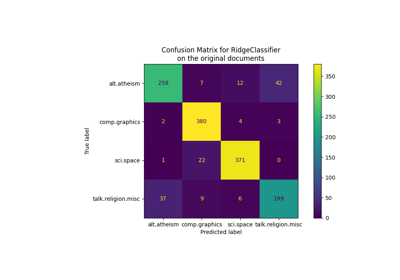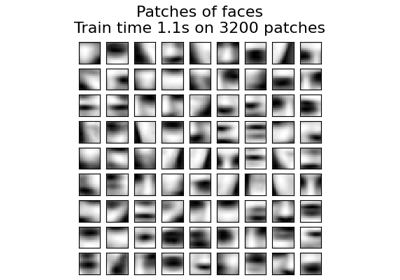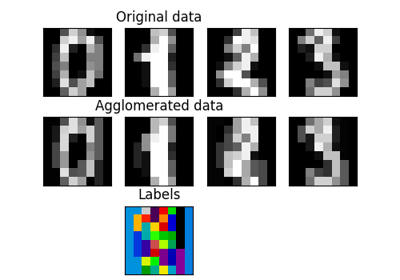备注
Go to the end 下载完整的示例代码。或者通过浏览器中的MysterLite或Binder运行此示例
使用特征脸和SVM的人脸识别示例#
本示例中使用的数据集是“Wild中的Labeled Faces”(又名LFW:https://www.kaggle.com/datasets/jessicali9530/lfw-dataset)的预处理摘录
# Authors: The scikit-learn developers
# SPDX-License-Identifier: BSD-3-Clause
from time import time
import matplotlib.pyplot as plt
from scipy.stats import loguniform
from sklearn.datasets import fetch_lfw_people
from sklearn.decomposition import PCA
from sklearn.metrics import ConfusionMatrixDisplay, classification_report
from sklearn.model_selection import RandomizedSearchCV, train_test_split
from sklearn.preprocessing import StandardScaler
from sklearn.svm import SVC
下载数据(如果尚未在磁盘上)并将其加载为numpy数组
lfw_people = fetch_lfw_people(min_faces_per_person=70, resize=0.4)
# introspect the images arrays to find the shapes (for plotting)
n_samples, h, w = lfw_people.images.shape
# for machine learning we use the 2 data directly (as relative pixel
# positions info is ignored by this model)
X = lfw_people.data
n_features = X.shape[1]
# the label to predict is the id of the person
y = lfw_people.target
target_names = lfw_people.target_names
n_classes = target_names.shape[0]
print("Total dataset size:")
print("n_samples: %d" % n_samples)
print("n_features: %d" % n_features)
print("n_classes: %d" % n_classes)
Total dataset size:
n_samples: 1288
n_features: 1850
n_classes: 7
分成训练集和测试集,并保留25%的数据用于测试。
X_train, X_test, y_train, y_test = train_test_split(
X, y, test_size=0.25, random_state=42
)
scaler = StandardScaler()
X_train = scaler.fit_transform(X_train)
X_test = scaler.transform(X_test)
在面部数据集(视为未标记数据集)上计算PCA(特征脸):无监督特征提取/降维
n_components = 150
print(
"Extracting the top %d eigenfaces from %d faces" % (n_components, X_train.shape[0])
)
t0 = time()
pca = PCA(n_components=n_components, svd_solver="randomized", whiten=True).fit(X_train)
print("done in %0.3fs" % (time() - t0))
eigenfaces = pca.components_.reshape((n_components, h, w))
print("Projecting the input data on the eigenfaces orthonormal basis")
t0 = time()
X_train_pca = pca.transform(X_train)
X_test_pca = pca.transform(X_test)
print("done in %0.3fs" % (time() - t0))
Extracting the top 150 eigenfaces from 966 faces
done in 0.371s
Projecting the input data on the eigenfaces orthonormal basis
done in 0.029s
训练支持机分类模型
print("Fitting the classifier to the training set")
t0 = time()
param_grid = {
"C": loguniform(1e3, 1e5),
"gamma": loguniform(1e-4, 1e-1),
}
clf = RandomizedSearchCV(
SVC(kernel="rbf", class_weight="balanced"), param_grid, n_iter=10
)
clf = clf.fit(X_train_pca, y_train)
print("done in %0.3fs" % (time() - t0))
print("Best estimator found by grid search:")
print(clf.best_estimator_)
Fitting the classifier to the training set
done in 3.880s
Best estimator found by grid search:
SVC(C=np.float64(76823.03433306457), class_weight='balanced',
gamma=np.float64(0.0034189458230957995))
测试集模型质量的定量评估
print("Predicting people's names on the test set")
t0 = time()
y_pred = clf.predict(X_test_pca)
print("done in %0.3fs" % (time() - t0))
print(classification_report(y_test, y_pred, target_names=target_names))
ConfusionMatrixDisplay.from_estimator(
clf, X_test_pca, y_test, display_labels=target_names, xticks_rotation="vertical"
)
plt.tight_layout()
plt.show()

Predicting people's names on the test set
done in 0.029s
precision recall f1-score support
Ariel Sharon 0.75 0.69 0.72 13
Colin Powell 0.72 0.87 0.79 60
Donald Rumsfeld 0.77 0.63 0.69 27
George W Bush 0.88 0.95 0.91 146
Gerhard Schroeder 0.95 0.80 0.87 25
Hugo Chavez 0.90 0.60 0.72 15
Tony Blair 0.93 0.75 0.83 36
accuracy 0.84 322
macro avg 0.84 0.75 0.79 322
weighted avg 0.85 0.84 0.84 322
使用matplotlib对预测进行定性评估
def plot_gallery(images, titles, h, w, n_row=3, n_col=4):
"""Helper function to plot a gallery of portraits"""
plt.figure(figsize=(1.8 * n_col, 2.4 * n_row))
plt.subplots_adjust(bottom=0, left=0.01, right=0.99, top=0.90, hspace=0.35)
for i in range(n_row * n_col):
plt.subplot(n_row, n_col, i + 1)
plt.imshow(images[i].reshape((h, w)), cmap=plt.cm.gray)
plt.title(titles[i], size=12)
plt.xticks(())
plt.yticks(())
在测试集的一部分上绘制预测结果
def title(y_pred, y_test, target_names, i):
pred_name = target_names[y_pred[i]].rsplit(" ", 1)[-1]
true_name = target_names[y_test[i]].rsplit(" ", 1)[-1]
return "predicted: %s\ntrue: %s" % (pred_name, true_name)
prediction_titles = [
title(y_pred, y_test, target_names, i) for i in range(y_pred.shape[0])
]
plot_gallery(X_test, prediction_titles, h, w)

绘制最有意义的特征脸图库
eigenface_titles = ["eigenface %d" % i for i in range(eigenfaces.shape[0])]
plot_gallery(eigenfaces, eigenface_titles, h, w)
plt.show()
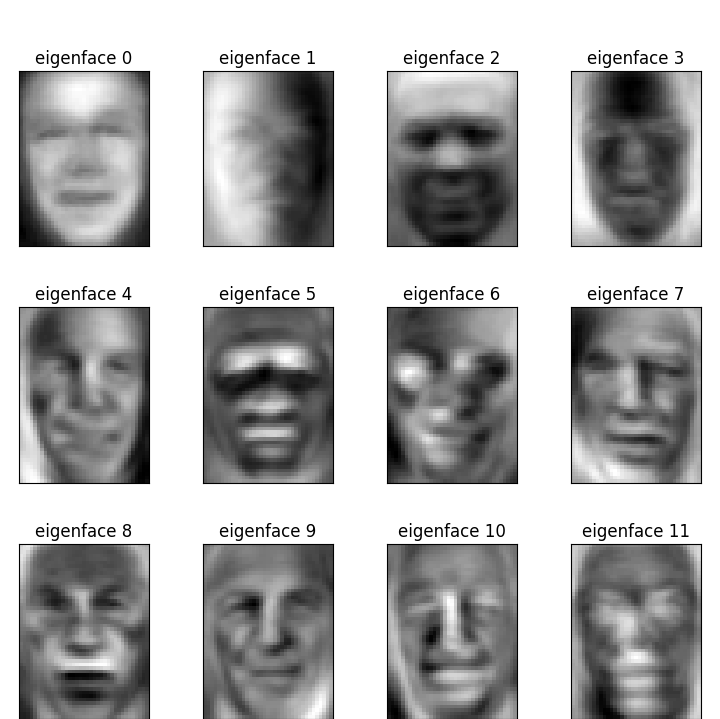
通过训练卷积神经网络可以更有效地解决面部识别问题,但这个模型家族超出了scikit-learn库的范围。感兴趣的读者应该尝试使用pytorch或tensorFlow来实现此类模型。
Total running time of the script: (0分4.806秒)
相关实例
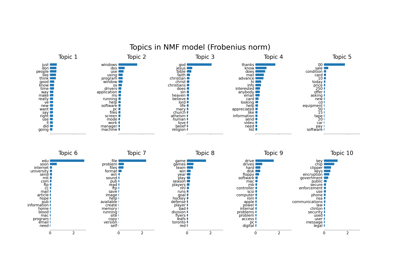
Topic extraction with Non-negative Matrix Factorization and Latent Dirichlet Allocation
Gallery generated by Sphinx-Gallery <https://sphinx-gallery.github.io> _

